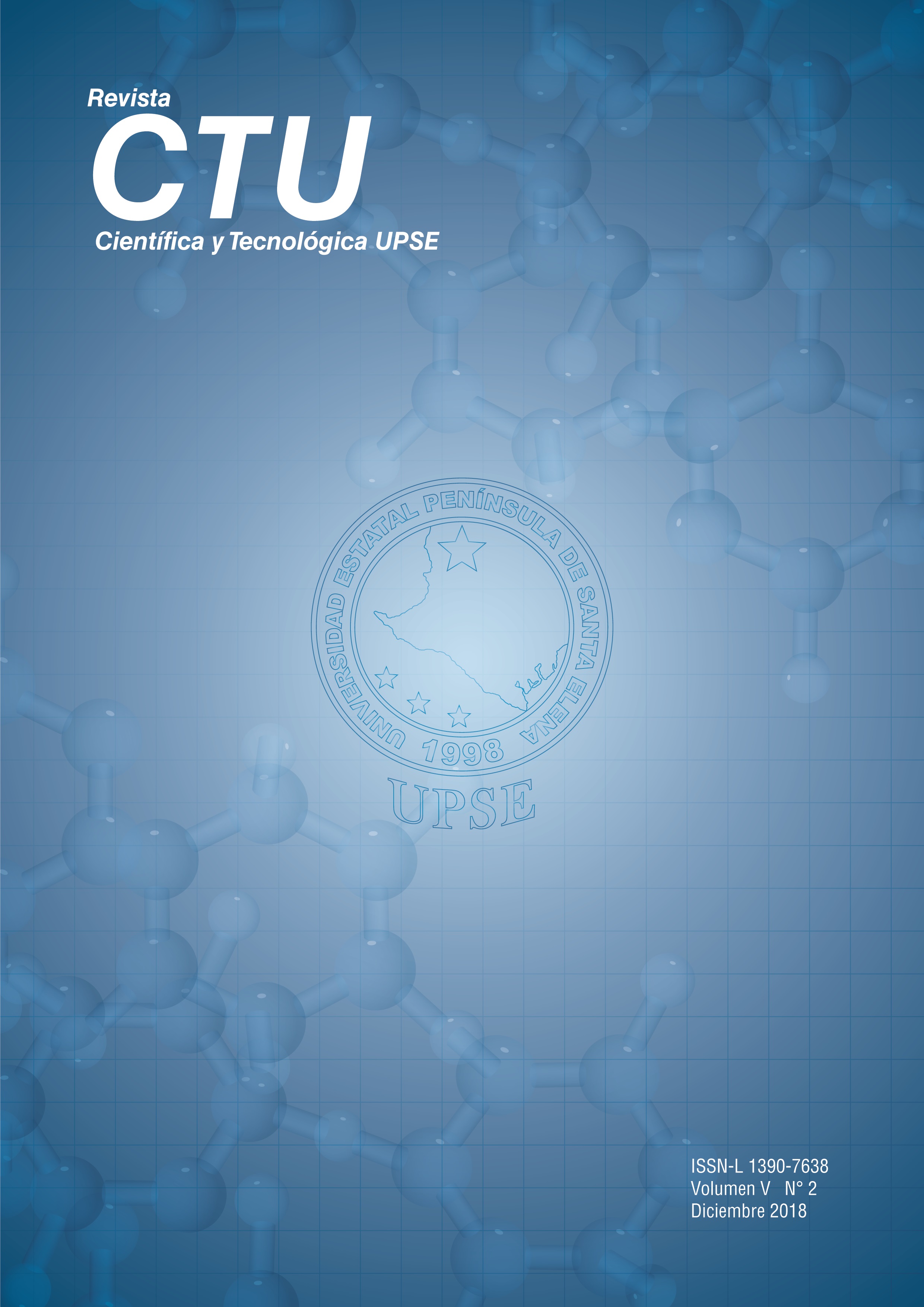Cuantificación de tres pesticidas COP en agua por el método de HPLC-UV
DOI:
https://doi.org/10.26423/rctu.v5i2.334Palabras clave:
Pesticidas organoclorados, Aldrín, Dieldrín, 4,4'-DDT, HPLC-UV-visible.Resumen
Fue validado un método de HPLC-UV-visible para la determinación de los pesticidas Aldrin, 4,4´-DDT y Dieldrin en agua. Para ello se empleó una columna C18 en fase reversa, una fase móvil que consistió en una mezcla acetonitrilo/agua, (v/v = 85:15) a una velocidad de flujo de 1 mL/min en forma isocrática, un volumen de inyección de 50 mL y un sistema de detección UV empleando dos longitudes de onda (Aldrin y Dieldrin a 220 nm y 4,4´-DDT a 238 nm). La validación del método se realizó determinando, la exactitud, la precisión, linealidad y rango lineal, límite de detección (LOD) y límite de cuantificación (LOQ). El método estudiado exhibe buena linealidad en el rango de 0,27 - 62 mg/Kg para Dieldrin, 0,14 - 42 mg/Kg para 4,4'-DDT y 0,34 – 81 mg/Kg para Aldrin, con un R2 mayor a 0,996. El porcentaje de recobro para dos concentraciones (2 y 20 mg/Kg) de estos tres pesticidas está en el rango de 91 – 104% con una desviación estándar relativa de 0,8 – 8%. El LOQ de los tres pesticidas, usando este método, es de 93, 95 y 135 ng/g para Dieldrin, Aldrin y 4,4'-DDT respectivamente.Descargas
Referencias
Aché, A. y Matos, A. (2001). Interrupting Chagas Disease Transmission in Venezuela. Rev. Inst. Med. trop. S. Paulo, 43(1), 37-43
Aché, A.; Medina, M. y Matos, A. (2008). Contribución de Dieldrinen el control de la Enfermedad de Chagas en Venezuela. Salus, Revista de la Facultad de Ciencias de la Salud. Universidad de Carabobo, 12(3), 17-20.
Alvarado, Y. y Pérez, C. (1998). El Uso de Biocidas: un Problema Ambiental. Interciencia, 23(1), 20-25.
Ballesteros, E. (2007). Analysis of Pesticides in Water. En: Leo Nollet (Editado), Handbook of Water Analysis (pp. 449-490). 2da Edición. Boca Raton: CRC Press.
Chen, L.; Ding, L.; Jin, H.; Song, D.; Zhang, H.; Li, J.; Zhang, K.; Wang, Y. y Zhang, H. (2007). The determination of organochlorine pesticides based ondynamic microwave-assisted extraction coupled with on-line solid-phase extraction of high-performance liquid chromatography. Analytica Chimica Acta, 589, 239–246.
Christian, G.D. 2009. Química Analítica. McGraw-Hill. Sexta Edición. México. 828 pp.
Cobzac,S. y Gocan, S. (2011). Sample Preparation for High Performance Liquid Chromatography: Recent Progress. Journal of Liquid Chromatography & Related Technologies, 34,1157–1267.
Convenio de Estocolmo sobre Contaminantes Orgánicos Persistentes (COP), (2009).
Feliciangeli, D. (2009). Control de la Enfermedad de Chagas en Venezuela. Logros Pasados y Retos Presentes. Interciencia, 34(6), 393-399.
Gasull, M., Bosch de Basea, M., Puigdomènech, E., Pumarega, J., Porta, M. (2011). Empirical analysesof the influenceof diet on human concentrations of persistent organic pollutants: A systematic review of all studies conducted in Spain. Environment International 37,1226–1235
Gil, M. (2006). Informe Ciudadano de la Situación de los Contaminantes Orgánicos Persistentes en Venezuela. Proyecto Internacional de Eliminación de los COP–IPEP. Venezuela: Caracas. http://www.aguaclara.org.pdf/pro-ipep-20060827.pdf.
Gonzáles, M.; Córse, P.; Cagnasso, M. y Urdaneta, A. (2007). Residuos de plaguicidas organoclorados en 4 tipos de aceites vegetales. Archivos Latinoamericanos de Nutrición, 57(4), 397-401.
Lehotay, S. y Mastovska, K. (2005). Determination of Pesticide Residues. En: Semih Ötleş (Editado), Methods of Analysis of Foods Components and Additives (pp. 329-360). Boca Raton: CRC Press.
Medina, C. (2008). Residuos de Plaguicidas Organoclorados en Yogurt de Diferentes Marcas Comerciales y Tiempos de Almacenamiento. Tesis de magíster scientiarum, Universidad del Zulia, Maracaibo. Miller, N.J. y Miller, J.C. 2002. Estadística y Quimiometría para Química Analítica. Prentice Hall. Cuarta edición. 278 pp.
Moreno, D.; Ferrera, Z. y Santana, J. (2006). Use of polyoxyethylene surfactants for the extraction of organochlorine pesticides from agricultural soils. Journal of Chromatography A, 1104, 11–17. Skoog, D.A.; Holler, F.J. y Crouch, S.T. 2008. Principios de análisis instrumental. Cengage Learning. Sexta edición. 1038 pp.
Urdaneta, E. Medina, B. y Acosta Z. (1994). Compuestos Organocloradosen Peces de una Estación de Piscicultura del Municipio Páez, Estado Zulia, Venezuela. Boletín del Centro de Investigaciones Biológicas, 28(1), 46-61.
Xu, W, Wang, X. y Zongwei, C. (2013). Analytical chemistry of the persistent organic pollutants identified in the Stockholm Convention: A review. Analytica Chimica Acta, 790, 1-13.
Publicado
Número
Sección
Licencia
El titular de los derechos de autor de la obra, otorga derechos de uso a los lectores mediante la licencia Creative Commons Atribución-NoComercial-CompartirIgual 4.0 Internacional. Esto permite el acceso gratuito inmediato a la obra y permite a cualquier usuario leer, descargar, copiar, distribuir, imprimir, buscar o vincular a los textos completos de los artículos, rastrearlos para su indexación, pasarlos como datos al software o usarlos para cualquier otro propósito legal.
Cuando la obra es aprobada y aceptada para su publicación, los autores conservan los derechos de autor sin restricciones, cediendo únicamente los derechos de reproducción, distribución para su explotación en formato de papel, así como en cualquier otro soporte magnético, óptico y digital.












